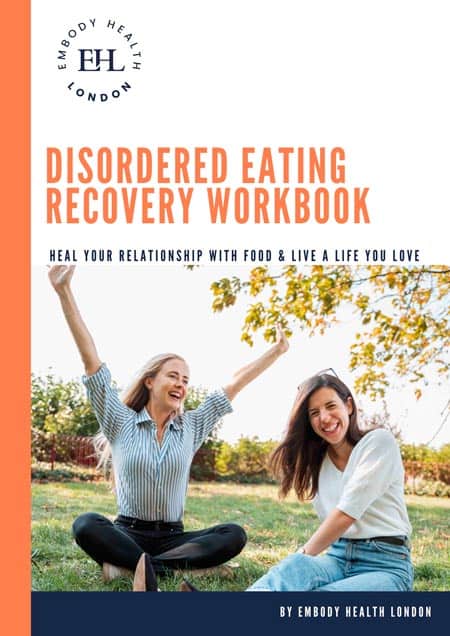Blog

How to Enjoy Exercise
Mindful movement – how to incorporate exercise in an enjoyable way
Movement. Exercise. Physical activity. Whatever you call it, humans were made to move.
You’re probably well-versed in the benefits of movement – namely improved physical and mental wellbeing. However, many of us have a relationship with exercise that’s far from healthy.
Did you know that exercising beyond your body’s ability can lead to injury, fatigue, sleep disturbances and problems with social relationships?1
Movement shouldn’t be a chore and it shouldn’t be about trying to change your body. Just as we promote eating intuitively here at Embody Health London, we also endorse moving intuitively! There are SO many ways that moving more can bring about benefits, and none of them have anything to do with shrinking our bodies.
Mindful movement (also known as intuitive movement or joyful movement) is the idea of connecting with your body before, during and after exercise to better understand your own needs.
Take the time to tune in – does your body need movement or does it need rest? What kind of intensity will feel good? What kind of activity will be enjoyable?
Remember that all movement is created equal – you don’t have to reach a certain intensity or meet particular goals for it to “count”.
In short, mindful movement emphasises a focus on how you want your body to FEEL, rather than how you want it to LOOK.
The benefits of mindful movement
Mindful movement is still a new concept in the world of scientific research. Although we are eagerly awaiting new research, what we know so far is extremely promising!
Studies have found that tuning into your body during exercise can help to prevent injury by trusting the body to indicate the intensity, frequency and duration of exercise it is capable of.2 People who exercise intuitively are also more likely to end or modify their activity if they experience pain or discomfort, which suggests that the rate of avoidable injuries caused by over-exercising could be reduced with mindful movement.3
Additionally, research indicates that women with a stronger appreciation for their body’s appearance, function and health are more likely to exercise intuitively.4 There is also evidence that women with positive body image engage in regular exercise with the intention to care for their bodies, improve their health, and seek enjoyment, which shows a strong relationship between good body image and a healthy relationship with physical activity.5
This suggests that when we feel negatively towards our bodies, it shows up in our behaviours. At present, it’s unclear how these factors are related, meaning it’s possible that exercising intuitively can increase body appreciation.
How to incorporate more enjoyment into your daily physical activity?
So we’ve sold you on the idea of viewing exercise as a source of joy rather than punishment, but you’re not sure where to begin. Here are four tips to get you started!
ONE: Change your perspective
Maybe you used to love running but you’ve forgotten how to have fun with it. Can you forget about tracking your times and just appreciate how the wind feels on your face, how strong your legs feel, how good it feels to breathe fully and deeply? Tune into your senses and find the joy in it!
TWO: Think about the types of movement you loved to do as a kid
It’s extremely common for girls to drop out of sports when they hit puberty, but there’s no time like the present to pick it back up! If you took dance classes as a child, search for an adult class near you. If you loved to swim, grab a membership to your local pool. Return to that child-like sense of joy and curiosity.
THREE: Be bold and try something new!
Some ideas include:
- Cycling
- Yoga or Pilates
- Rock climbing (indoors or outdoors)
- Hiking
- Rollerblading
- Swimming
- Tennis
- Team sports (like basketball or softball)
- Group classes (such as dance, kick boxing, aerial fitness or martial arts
FOUR: Integrate more movement into your everyday life
- When you chase your kids around the yard, that’s joyful movement!
- When you play tug-of-war with your dog, that’s joyful movement!
- When you dance in your room when no one’s watching, that’s joyful movement!
Exercise doesn’t need to be planned and tracked to have health benefits.
Finally, let us leave you with this reminder:
You don’t need to buy a gym membership to be healthy.
If you love it, carry on! But if you haven’t found a type of movement that you truly enjoy yet, just know that there are so many more ways to move your body than just running on a treadmill and doing HIIT workouts. You just have to find what works for you!
Let’s leave the phrase “no pain no gain” in 2020.
If you would benefit from one-on-one support to heal your relationship with exercise, we would be honoured to help you! Reach out to us at [email protected] to book your free enquiry call with one of our dietitians.
Karli Battaglia MDiet, APD
EHL Team x
References
- Taranis L, Meyer C. Associations between specific components of compulsive exercise and eating-disordered cognitions and behaviors among young women. International Journal of Eating Disorders. 2010;44(5):452-458.
- Calogero R, Pedrotty-Stump K. Incorporating Exercise into Eating Disorder Treatment and Recovery. Treatment of Eating Disorders. 2010;:425-441.
- Reel J. The Right Dose of Activity: Health Educators Should Promote Mindful and Intuitive Exercise. Journal of Community Medicine & Health Education. 2012;2(9):1-2.
- Ramsey N. Exploring Positive Body Image and Motives for Exercise as Predictors of Intuitive Exercise and Exercise Behavior Among Women [MS]. The University of Wisconsin; 2018.
- Wood-Barcalow N, Tylka T, Augustus-Horvath C. “But I Like My Body”: Positive body image characteristics and a holistic model for young-adult women. Body Image. 2010;7(2):106-116.














